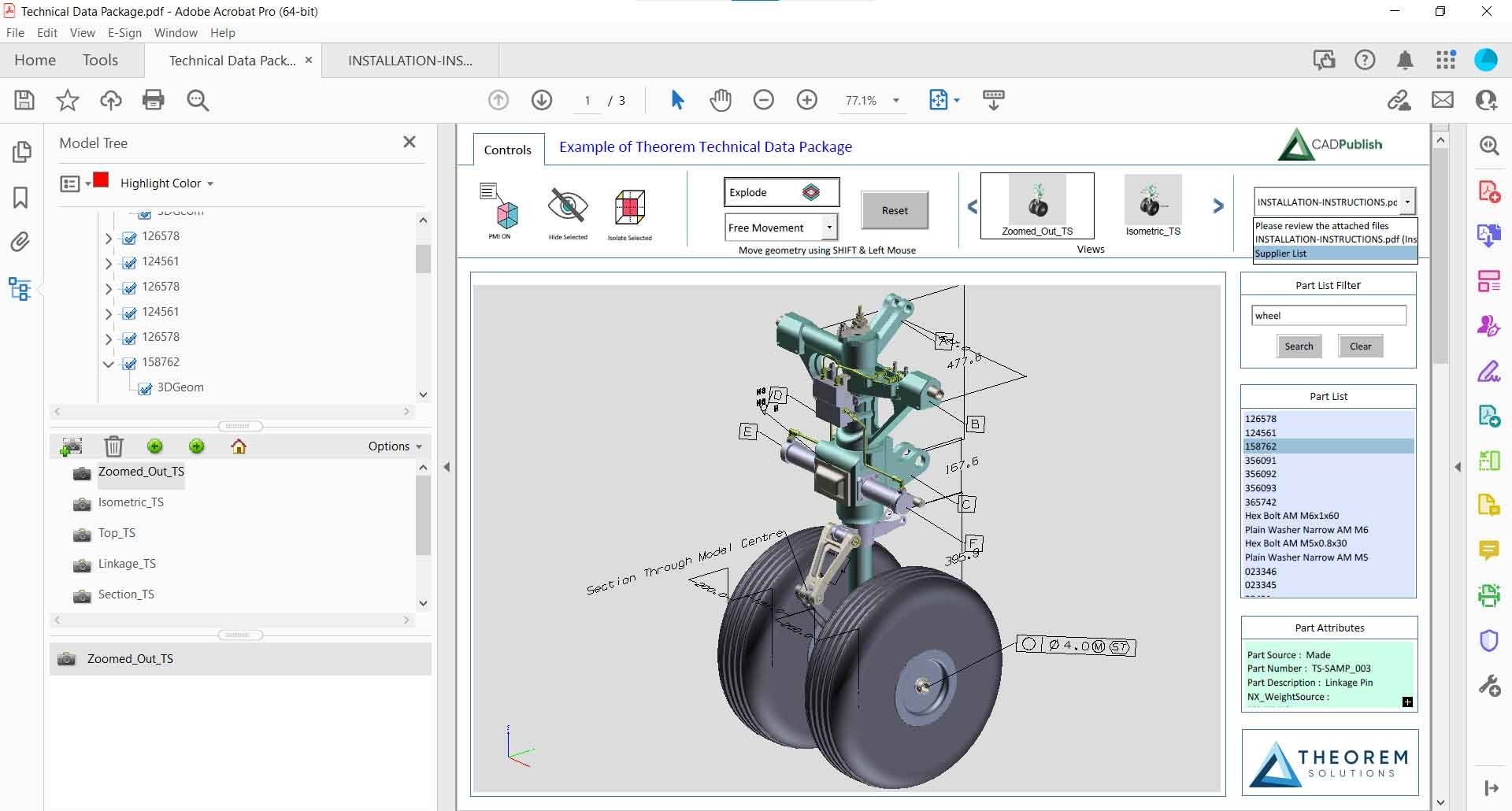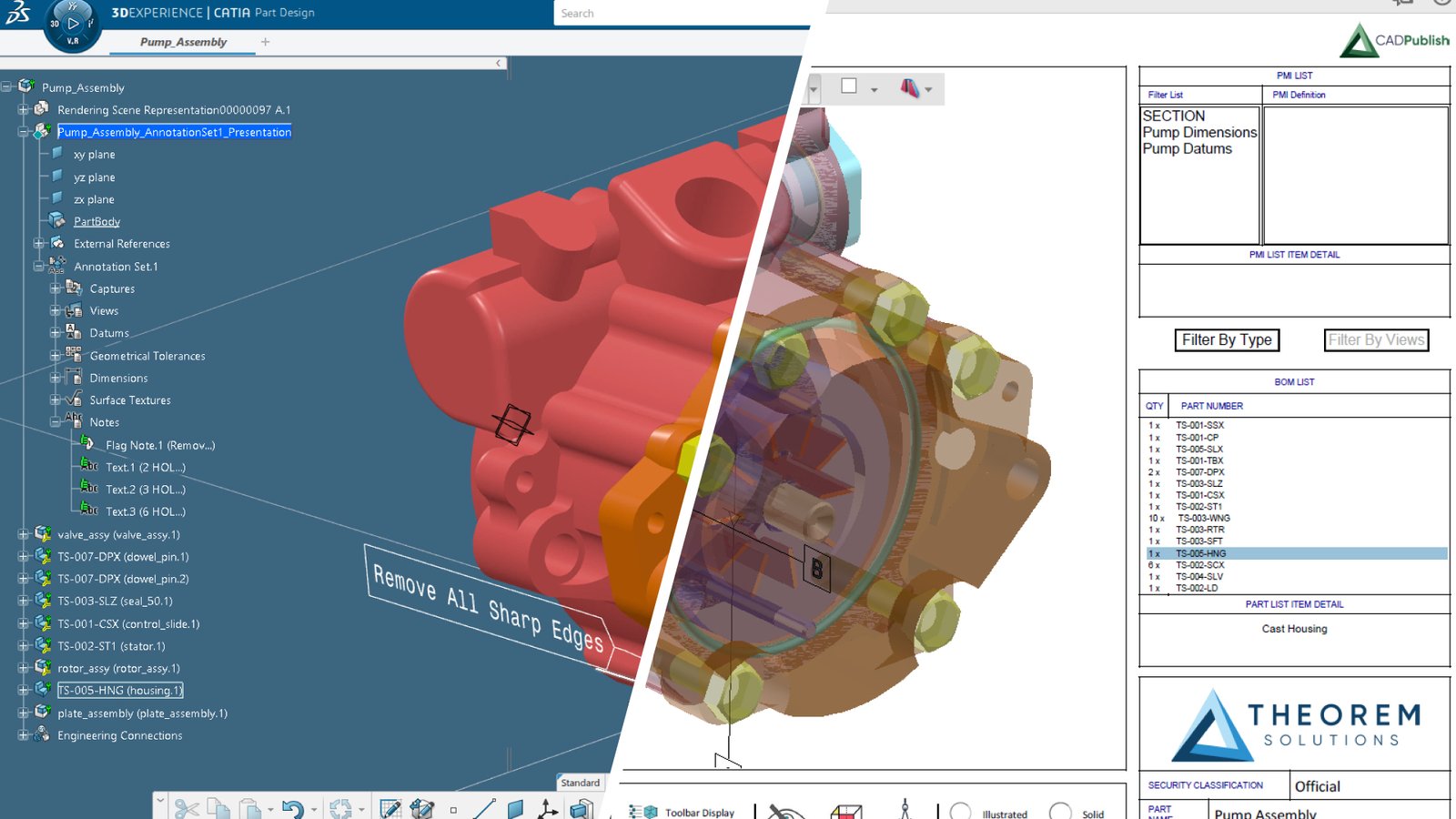Our recent webinar, hosted by Theorem Solutions’ senior account manager Clair Baxter, explored how 3DEXPERIENCE users can use 3D PDF documents (with embedded Model-Based Definition data) to transform supplier communication.
So, let’s take a look at some of the key points discussed and learn more about how 3D PDF can help you get more out of your CAD data. Although this webinar focused on 3DEXPERIENCE, the main principles can also apply to other CAD systems, such as CATIA V5, Creo, NX, and JT.
What is 3D PDF?
With CADPublish (Theorem Solutions' 3D PDF publisher), 3DEXPERIENCE users are able to export data directly into the rich 3D PDF format. 3D PDF allows CAD data, and additional important information to be shared with downstream users. Since PDF documents are familiar and easy to share, they are an amazing option for collaborating around CAD data.
One of the most powerful features of a 3D PDF document is the ability to share Model Based Definition (MBD) data, alongside your 3D design data. PMI/GD&T/FTA can all be carried through from 3DEXPERIENCE into the PDF, allowing this information to easily be shared.

Why Use 3D PDF?
There are many reasons why someone may want to use 3D PDF, particularly with the ability to share MBD. We break down the benefits of 3D PDF into three key takeaways: Security, Communication, and Efficency.
- Security: 3D PDF can help keep your design data secure. With 3D PDF you can share the information you need without having to send the original 3DEXPERIENCE CAD file, helping to protect your IP. Along with this, there are a number of features that can be implemented on your documents to help protect it, including password protection, encryption, watermarks, time bombs, and digital rights management.
- Communication: Since all that’s required to open a 3D PDF is the free Adobe Acrobat Reader, 3D PDFs can provide universal access to your 3D design data that downstream non-CAD users typically wouldn’t have. This means that users can share data with a wide range of people, both internally and with the wider external supply chain.
- Efficiency: We find that 3D PDFs are used heavily in MBD projects in particular. This ability to share Model Based Definition information (such as PMI/GD&T/FTA) and CAD data together in one document can make processes much more efficient. To add to this, 3D PDF can also help companies meet green initiatives by introducing paperless workflows, since 3D PDF reduces the need for paper drawings. This data rich documentation can also allow companies to decrease the number of CAD licenses they need, as users who simply need to view the data can do so with the 3D PDF document.
Using a 3D PDF as a Technical Data Package

One common use for 3D PDFs is the creation of Technical Data Packages (TDP). Our Technical Data Package templates contain the 3DEXPEREINCE CAD model with the associated PMI. Along with the ability to hide/show or isolate sections and view the parts list with the part attributes. Users can also include pre-prepared views of the model that can be selected.
With the Technical Data Package users can attach files to the PDF document, enabling other files to be sent along with the model and information included on the document. A wide range of files can be included, such as native CAD data, STEP files, PDF files, JPEGs, or Excel spreadsheets.
2D drawings can also be attached to the Technical Data Package. There can sometimes be a reluctance to move away from traditional processes, particularly among those who have used 2D drawings for a long time. TDPs are an excellent way to incorporate those 2D drawings into the 3D PDF document to improve processes, without abandoning 2D drawings entirely.
Simple to Create
Theorem’s CADPublish software makes the creation of these documents easy. With the standard Create license users can “export as” from within 3DEXPERIENCE directly. The Enhance license also includes batch processing, enabling users to select multiple data sets at once to be exported. It also supports command line processing, so users can run scripts and triggers from the command line to integrate with your PLM system.
3D PDF Templates
3D PDFs allow users to create very rich documentation, and depending on the templates used they can have a wide range of use cases. With CADPublish, nine templates are provided as standard; however, templates can also be created from scratch to ensure the documentation is tailored to the specific use case. Templates can also include company branding and be formatted to look more uniform with other internal documentation.
Here are some examples of templates to showcase what 3D PDF can be used for:
- Bill of Materials: Enables you to select parts in a table that are highlighted in the model above to bring instant access to your designs.
- Data Exchange Notice: Include 3D data alongside important manufacturing information in your data exchange notices.
- Marketing Brochure: Create unique and memorable marketing materials.
- Work Instructions: Provide specific views of a CAD model for each stage of a process and include instructions alongside this visual.
- Animation Data: Bring CAD designs to life with animation to showcase moving parts.
- Request for Quotation: Aid supplier understanding by providing the CAD model when you’re doing your RFQs.
- Military Standard Template: Meeting the specific requirements for security around data sharing for Military Standards.
In Summary
There are many benefits to using 3D PDF to share your 3DEXPERIENCE data. They allow you to securely share your data while also enhancing communication by making it available to anyone and improve efficiency by creating documentation with Model Based Definition. Templates can help tailor 3D PDFs to your specific use case enabling a wide range of different types of documentation to be created.
If you want to learn more about how 3D PDF could enhance your 3DEXPEREINCE platform, check out the webinar recording. To learn more, get in touch with our team of specialists, or request a 3D PDF evaluation today. You can also follow us on LinkedIn and Twitter for the latest news and updates.



